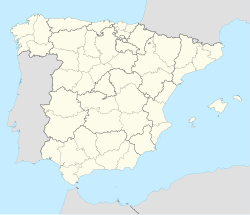Torrelavega
Torrelavega
Torlavega (Asturian) | |
|---|---|
 Church of Nuestra Señora de la Asunción. | |
| Motto(s): Ave Maria (Hail Mary) | |
 Location of the Municipality of Torrelavega in Cantabria. | |
| Coordinates: 43°21′11″N 4°2′45″W / 43.35306°N 4.04583°W | |
| Country | |
| Autonomous community | |
| Province | Cantabria |
| Comarca | Valle del Besaya |
| Founded | 14th century as Torre de la Vega |
| Government | |
| • Alcalde | Javier López Estrada (2019) (PRC) |
| Area | |
• Total | 35.54 km2 (13.72 sq mi) |
| Elevation | 25 m (82 ft) |
| Highest elevation | 606 m (1,988 ft) |
| Lowest elevation | 12 m (39 ft) |
| Population (2018)[1] | |
• Total | 51,687 |
| • Density | 1,500/km2 (3,800/sq mi) |
| Demonym | Torrelaveguenses |
| Time zone | UTC+1 (CET) |
| • Summer (DST) | UTC+2 (CEST) |
| Postal code | 39300 |
| Official language(s) | Spanish |
| Website | Official website |
 | |
| Click on the map for a fullscreen view | |
Torrelavega (Asturian: Torlavega) is a municipality and important industrial and commercial hub in the single province Autonomous Community of Cantabria, northern Spain.
It is situated roughly 8 kilometres from the Cantabrian Coast and 27.5 kilometres from the capital of the Autonomous Community, Santander, halfway between the Principality of Asturias and the Basque Country. The rivers Saja and Besaya flow through the city.
It is the capital of the comarca (county, but with no administrative role) of Valle del Besaya which includes also composed of the municipalities of Suances, Polanco, Cartes, Los Corrales de Buelna, Cieza, Arenas de Iguña, Bárcena de Pie de Concha, Molledo, Anievas and San Felices de Buelna.
Its highest point is 606 metres and its lowest point is 12 metres.
Torrelavega is a regional centre for industry and transport, and its weekly livestock fair is famous in Spain. Its stadium is known as El Malecon. The Cave of Altamira, famed for the prehistoric paintings found inside, is about 10 kilometres northwest of the city.
History
[edit]Torrelavega was founded at the end of the thirteenth century by Garci Lasso de la Vega I (the elder), Adelantado Mayor of the Kingdom of Castile in the name of King Alfonso XI of Castile.
Its current name is due to the contraction of the original eponym of "Torre de la Vega". The Castle or Tower of the Vega's was built by Leonor Lasso de la Vega, daughter of Garci Lasso de la Vega II, the younger, and mother of the Íñigo López de Mendoza, marqués de Santillana in order to administer the tax and privilege due in the family's territory.


The name of the comarca, Valle del Besaya is derived from the Astur-Leonese Bisalia, which in turn derives from the Celtic, Bis-salia (the second Salia or Saja) from the two rivers that flow through the city.
Torrelavega was an important agricultural hub in the Kingdom of Castile since medieval times. Continuous population growth and industrial development enabled Torrelavega to attain city status in 1895 from the Queen Regent Maria Christina of Bourbon, Princess of the Two Sicilies.
The city is home to the main seat of the Spanish anarcho-syndicalist labour union the Confederación Nacional del Trabajo.
Geography
[edit]Divisions
[edit]- Barreda
- Campuzano
- Duález
- Ganzo
- La Montaña
- Sierrapando
- Tanos
- Torrelavega (Metro)
- Torres
- Viérnoles
Neighbourhoods within the Metropolitan Area
[edit]- La Inmobiliaria
- El Barrio de Sorravides
- El Barrio Covadonga
- La Nueva Ciudad
- El Zapatón
- El Poblado
Neighbouring municipalities
[edit]- North: Santillana del Mar, Suances and Polanco.
- South: Los Corrales de Buelna and San Felices de Buelna.
- East: Piélagos and Puente Viesgo.
- West: Reocín and Cartes.
Notable people
[edit]- Óscar Freire, spanish cyclist.
- Juanjo Cobo, spanish cyclist.
- Dani Sordo, Rally Driver.
- Antonio Resines, Actor.
Twin towns – sister cities
[edit]Torrelavega is twinned with:[2]
 Louga, Senegal
Louga, Senegal Old Havana, Cuba
Old Havana, Cuba Rochefort, France
Rochefort, France Zug, Western Sahara
Zug, Western Sahara
References
[edit]- ^ Municipal Register of Spain 2018. National Statistics Institute.
- ^ "Un hermanamiento lejano". eldiariomontanes.es (in Spanish). El Diario Montañés. 2016-12-01. Retrieved 2021-01-28.
External links
[edit]- http://www.oviedo.es/index.php/es/la-ciudad/ciudades-hermanadas Oviedo´s sister city is Torrevieja, not Torrelavega.



